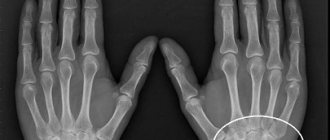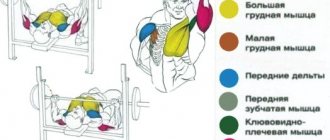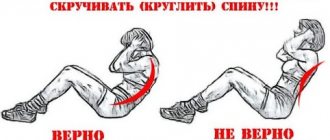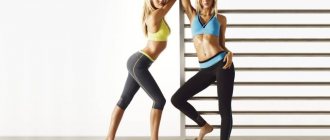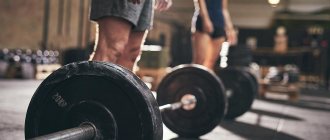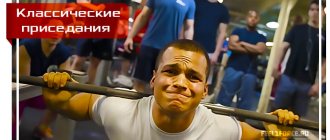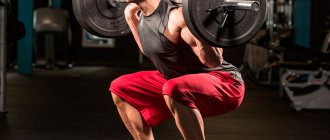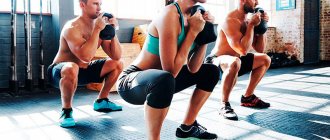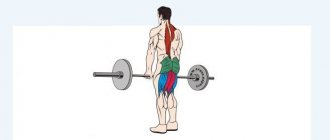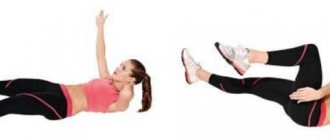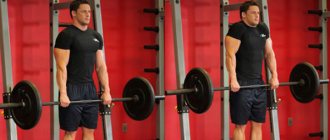Correct technique
Place your feet shoulder-width apart. Position your feet so that your toes are slightly turned out to the sides. Point your knees and toes in one direction. Shift your body weight to your heels. Press your feet firmly to the floor and do not lift them throughout the entire exercise. Keep your lower back with a slight arch. Do not round it, including in the thoracic region. Try not to lean forward. Watch your posture. Do not bring your knees in or spread them out to the sides when rising from a low position. The knees should “look” in the same direction as the feet. Also try not to bring your knees forward beyond the level of your toes. Take a deep breath at the beginning of the exercise. In the future, when rising, you need to exhale, when lowering, inhale. You need to lower yourself at least until your thighs are parallel to the floor. Even deeper is better, although this depends on the purpose of the exercise. There is no need to straighten your legs all the way at the top point. Just before reaching full straightening, immediately begin moving downwards. In one workout, you need to perform 15-20 squats, 3-5 approaches.
Rules for performing exercises
There are a huge number of exercises that are based on squats. Each complex has a special technique and nuances of execution that are unique to it. Some squats are good for gaining muscle mass or pumping up certain muscle groups, others help to shape your figure or say goodbye to extra pounds. But all squats are united by general rules that must be adhered to without fail when performing any set of exercises:
- Be sure to choose comfortable shoes and clothes, as discomfort will not only irritate you, but will also prevent you from accurately adhering to the main squatting techniques.
- For partial squats, there should be a right angle between each thigh and the calf of the corresponding leg.
- The pelvis is always pulled back a little.
- It is important to keep the abdominal and back muscles tense so that it seems as if you are in a corset.
- You cannot slouch - your back should always remain straight.
- The knees should be in a straight direction, that is, they should not be turned inward or to the side.
- Watch your breathing.
- Do not make sudden jerks, squat and rise smoothly.
- It is strictly forbidden to raise your heels - they must lie firmly on the floor.
Remember that the completeness of squats is influenced by the physical preparation of the athlete. Therefore, partial squats are better for beginners, since during such exercises there is a large load on the body.
Jump Squats
Jump squats are a very high-intensity exercise. Thanks to this exercise, we train the quadriceps muscle of the thigh (quadriceps) and strengthen the buttocks. Also, but to a lesser extent, we train the muscles of the back, abs and lower legs. Good for those who want to lose weight. Place your feet shoulder-width apart. The back is straight. We go down - take a breath, while squatting to parallel with the floor or a little lower, if you can do it. As you exhale, jump up as high as possible, while you need to push off with your full feet, and not with your toes. After landing, we repeat the entire sequence (it is important to land on both legs at the same time, slightly bending your legs), while it is important to maintain the pace of the exercise. Perform the exercise for 30-60 seconds and rest for 60 seconds. You can perform 3-5 rounds per workout.
15-minute workout for a small waist (video)
About deep squats
I’m answering the main question from the last post about squats Why do I do them and why are they deep: Many people are interested in the topic of deep squats and their use in training. At the same time, different trainers recommend almost the opposite approach to this issue. That is, some believe that deep squats are completely useless, while others actively recommend including this exercise in the training process. Ultimately, of course, it is up to you, and only you, to decide for yourself whether you need deep squats or not. To do this, it won’t hurt to figure out why this exercise even exists and what results it can give. * If, for example, you want to work out the upper thighs well, but the load on the buttocks and knees is not desirable, then not deep squats (“as if sitting on a chair”), but squats with a barbell on the chest are suitable for you. * In the case of deep squats, the deeper you squat, the more stress your buttocks will receive, as well as your knee joints. Please note that the load of the latter will be quite dangerous if you use a lot of weight . In this case, the likelihood of injury increases! That’s why I do deep squats with an acceptable weight for me and don’t hang weights on the bar. If you want to perform deep squats, you need to understand that deep squats are considered to be squats when the lines of the hips are no longer parallel to the floor, but fall further down.
* In the case of deep squats, mainly the buttocks swing, * Whereas in the case of “chair-like” squats, where the thighs are parallel to the floor, the legs swing more. BOTH OPTIONS ARE CORRECT! DO THE ONE YOU NEED TO ACHIEVE YOUR GOAL! **** To begin, to understand how much deep squats you need, try doing a large number of squats without using any weight at all. This assistance exercise will help you understand more clearly whether you need to include deep squats in your training process or not. There are also deep squats with legs wide apart. This exercise works well on both the hips and buttocks. In this regard, this exercise is mainly recommended for girls and women of any age. Thanks to the very wide stance of the legs, these squats are very effective even without the use of any weights. However, after trying such deep squats several times, you will most likely feel whether your body is ready for more serious loads and adding weight. You can start using weights using small dumbbells or one medium dumbbell.
Squats with dumbbells
They can be used in the gym and for home workouts. At home, novice athletes often use bottles of sand or water instead. Take dumbbells in your hands. Get into the starting position with your feet shoulder-width apart. Look straight, pointing your gaze slightly upward (this will allow your back to be in the correct arched position). As you inhale, slowly squat down, bending your knees. Continue the downward movement until your thighs are parallel to the floor. Smoothly rise to the starting position until your legs are not fully straightened.
Don't get fat! Training from gymnast Samira Mustafaeva
Work of muscles and joints
Knowing the structure and functions of muscles, you can avoid injuries and provide the necessary load.
When squatting, the following muscle groups work:
- quadriceps (that is, the quadriceps femoris muscle, which is responsible for straightening the legs at the knee);
- the gluteus maximus muscle, whose function is to straighten the torso and move the legs back and to the side;
- calf muscle, which provides balance;
- back and abdominal muscles;
- thigh biceps.
Find out the benefits of squats for men and women.
Despite the complexity of the technique, it can be noted that for women this type of squat is the most effective, as it allows you to achieve quick and desired results.
But still, this type of exercise should be approached wisely so that the legs do not look pumped, because the main load when performing falls on the front surface of the thigh.
Important! If you come to the gym for the first time, under no circumstances try to use the exercise machines on your own; it is better to contact a trainer, he will help you create a training program that is suitable for you personally, which will make your sports activities much easier.
Plie squats with weight between legs
This is one of the most effective hip exercises. Great for women who want to get a seductive gap between their thighs by tightening their inner thighs.
Take a dumbbell. Stand straight, place your feet wider than shoulder-width apart. As you inhale, lower yourself as low as possible - as far as the flexibility of your hip joint allows. Bend your back forward as little as possible! At the bottom, pause for a split second, hold your breath, tighten your hips and buttocks, and begin to rise. Finish the rise with a sharp exhalation and straighten up.
How Ankle Mobility Affects Squats
Many people have a rounded back when squatting at the bottom point, which is dangerous for the spine. This problem is often associated with the ankle.
If your ankle joint is not mobile enough and the dorsiflexion of your foot is difficult, then you have to hold your pelvis higher to maintain balance.
Angle of shin flexion
Squats with an elastic band
The elastic band allows you to significantly increase the load. This occurs due to the resistance force that you are forced to overcome, simultaneously with the load of the squats themselves. Place the elastic band around your shins. Feet shoulder-width apart, body slightly forward, back straight. Hands clasped in front of you. Perform regular squats until your knees are at a right angle. Make sure that during squats your knees do not go beyond the level of your toes, and also do not come together. When lifting to the starting position, add leg abduction to the side. When the leg is abducted, the knee is straight. Alternate between lifting your right and left legs.
What muscles work
A deep squat with a barbell differs from classic squats only in the amplitude of movement, so it cannot be said that fundamentally different muscle groups are involved.
The only difference is the number of muscle fibers worked. So, when performing deep squats with a barbell, they work:
- Quadriceps;
- Gluteus maximus muscles;
- Adductor muscles;
- Calf muscles;
- Back muscles (especially the lower back), which act as stabilizers;
- The abdominal muscles, like the back muscles, act as stabilizers.
Squats with an overhead exercise ball
Ready to use your arms and legs? For this arm exercise, squat down while holding the ball above your head with your arms outstretched. Add weight (the exercise ball is not that light) while keeping your torso upright and engage your shoulders and deltoids.
See also: fitness with your husband: active workout for two
Weight loss
A person who weighs, for example, 70-80 kg, squats 100 times, burns about 40-50 calories. It is worth noting that the greater a person’s body weight, the more calories he will be able to burn.
In order to enhance the effect of squats, you can use weights or dumbbells. In this case, when performing 100 squats, the number of calories lost can be increased to 200-400, depending on the intensity of the load.
Practice shows that correctly performed exercise allows you to lose at least 1-2 kg in a couple of weeks. Remember that in the process of performing a standard complex, the body is sufficiently saturated with oxygen, and metabolic processes are accelerated.
The results of these observations clearly demonstrate that to lose weight, it is best to do squats in the morning. Accordingly, if your goal is to build muscle, then the optimal time to perform the exercise is in the evening.
Strengthening the cardiovascular system
By doing 100 squats a day, a person strengthens his cardiovascular system. This effect is due to the fact that during the exercise the venous circulation begins to function more actively, as a result of which blood immediately flows to the heart.
Against the background of the ongoing processes, the work of the heart muscle is noticeably facilitated, and its training is also carried out.
Few people realize that regular squats affect the strengthening of the respiratory and nervous systems of the body, as well as the vestibular apparatus.
What does "Just Squat" mean?
If you take this phrase literally, it could mean that all you need to develop your legs is squats and nothing else.
But some people, when they say “Just squat,” mean working all the muscles except the hamstring group (so calf curls are not excluded from the workout in this case). Sometimes this recommendation is also given by those who, in addition to squats, do deadlifts or glute bridges. In their understanding, the phrase “Just squat” refers only to the quadriceps.
Regardless of the context that is put into this recommendation, I suggest considering 2 questions:
- Are squats a good exercise for developing hamstrings?
- Are squats effective for developing all heads of the quadriceps muscle?
Improved stamina
After the first squats, it is impossible to feel the positive effect. All a person feels in the first two days is muscle pain and fatigue. At this moment, the main thing is not to give up and continue to do the exercise correctly and, most importantly, every day.
Squeeze your hand around your wrist. Chinese pain relief technique
What films about dogs should Julbars fans watch?
You still have to treat me: a cow looked into the classroom where future veterinarians studied
Practice shows that after a week, 100 squats are quite easy, and after 10 days the first effect will become noticeable. After just three weeks, the legs become quite dense, and the person stops experiencing shortness of breath during physical activity.
Why do the muscles of the back surface weakly engage during squats?
If we consider this issue from a biomechanical point of view, then, most likely, weak activation of the posterior muscles during squats is due to the fact that these muscles are bi-articular. They work as both hip extensors and calf flexors.
So, when you lower yourself into a squat (flexing your hip and shin), the muscle contracts closer to the knee but stretches closer to the hip joint. Roughly speaking, its length remains almost unchanged. When you rise from a squat (extending your hip and lower leg), the opposite happens - the muscle stretches closer to the knee, but contracts near the hip joint. Again, its length remains almost unchanged. This makes the hamstrings less effective as hip extensors during squats.
You might say, “I don’t care what the research says about lack of activation, I can feel my hamstrings firing when I squat.” And, of course, I will not argue with this.
You should really feel the muscles in the back of your thigh working during squats - that's where the adductor magnus is located. This is a very large muscle that is an important hip extensor during squats. It is located next to the muscles of the back surface, so in most cases you feel its work.
Increased ability to work
A person who regularly squats feels a real surge of vitality, as a result of which his level of ability to work increases. All this is due to the beneficial effects of exercise on brain cells and blood vessels.
Eruption. A beautiful new saucepan let a woman down: photo
Easy to cook, easy to serve: a woman shared a “lazy” cheesecake recipe
The military thriller “Death List” with Chris Pratt has found a home on Amazon
Within a week from the moment the exercise begins, a person becomes more energetic, stress-resistant, as well as focused and attentive.
Giving your figure clearer lines
After 6-8 weeks of regular and correct squats, the body begins to take on clearer shape. Thus, the lines of the hips and waist become more precise, and the buttocks acquire pleasant elasticity. The changes also affect the abdominal press - it becomes pronounced and toned.
“I Believe with all my Heart!”: Daily Prayer to Meet Your Needs
May 8 - St. Mark: why is it so important to hear the cuckoo on this day (signs)
Spring cleaning of your cosmetic bag: a cosmetologist friend gave advice
As for men, as a result of squats, their legs become more prominent. Speaking about the female figure, it should be noted that the waist noticeably decreases in volume.
Visible positive changes in the gluteal muscles can be achieved when the number of squats gradually increases to 200 per day. Ideally, they are performed with weights.
